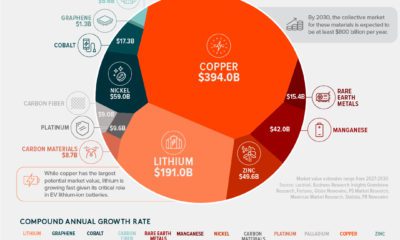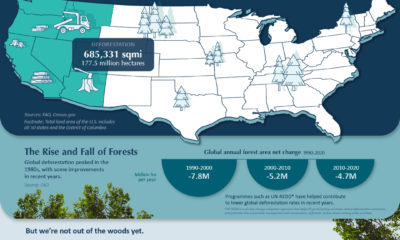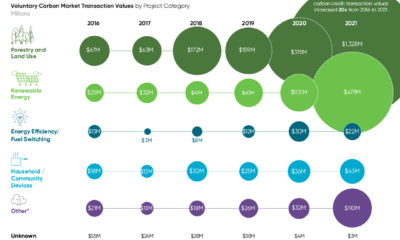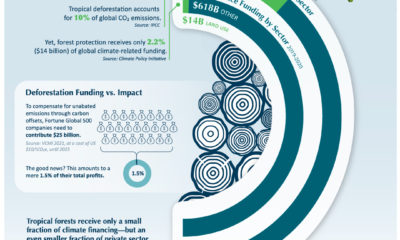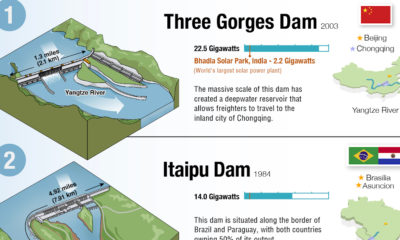This process of cause and effect works much the same way in society and business: as global forces take hold, their effects are deeply intertwined with the financial markets.
The Climate Megatrend
Today’s infographic comes from BlackRock, and it explains how one such megatrend, climate change and resource scarcity, will be a long-term opportunity for investors.
Earth in the Hot Seat
In 2018, global CO2 emissions rose 1.7% to the highest level since 2013. These rising emissions have intensified the effects of climate change, with 2015-2018 being the four hottest years ever recorded. Society and the economy are starting to feel its negative consequences:
Extreme weather events have become more frequent. In particular, floods and other hydrological events have quadrupled since 1980. In hotter, wetter conditions, infectious diseases spread more easily—between 2004-2017, total tick-borne illnesses increased by 163%. The global insured losses from natural catastrophes was $79 billion in 2018. Extreme weather effects, and the health impact of burning fossil fuels, cost the U.S. economy at least $240 billion in 2018.
It’s clear that climate change is having an immediate, serious impact on the world. -Brian Deese, Global Head of Sustainable Investing at BlackRock In addition to these issues, climate change is contributing to another problem: it’s becoming harder to feed the global population.
Over 7 Billion Mouths to Feed
Climate change significantly threatens global food security. As glaciers melt, the world’s freshwater supply—including what’s available for food production—melts with it. This is a significant problem, considering that between 2,000-5,000 liters of fresh water are needed to produce one person’s daily food intake. As an added hurdle to food production, supply and demand are pulling in opposite directions. The share of total employment in agriculture has dropped significantly over time. Even worse, among the food that is able to be harvested, roughly 30% is lost or wasted globally. On top of limited resources, the world will have to contend with forces driving up food demand.
Population growth: By 2050, the global population will grow by about two billion. More calorie-rich diets: As emerging economies grow their wealth, their populations seek richer foods like meat and dairy products.
How can society combat these pressing issues?
A Greener, More Plentiful Future
As society works to slow climate change and produce more with less, a myriad of investment opportunities will emerge.
Renewable energies are becoming increasingly competitive. Electric & fuel cell vehicles are growing in market share. Products made from recycled materials are appealing to environmentally-conscious consumers. Agricultural machinery counters the declining workforce and increases productivity. Precision agriculture leverages real-time environmental data to help farmers make decisions.
Climate change and resource scarcity will be a driving force behind the actions of consumers, companies, and governments for years to come. By staying attuned to this megatrend, investors will be able to spot long-term opportunities. on Over recent decades, farmers have been able to more than double their production of crops thanks to fertilizers and the vital nutrients they contain. When crops are harvested, the essential nutrients are taken away with them to the dining table, resulting in the depletion of these nutrients in the soil. To replenish these nutrients, fertilizers are needed, and the cycle continues. The above infographic by Brazil Potash shows the role that each macronutrient plays in growing healthy, high-yielding crops.
Food for Growth
Nitrogen, phosphorus, and potassium (NPK) are three primary macronutrients that are the building blocks of the global fertilizer industry. Each plays a key role in plant nutrition and promoting crop growth with higher yields. Let’s take a look at how each macronutrient affects plant growth. If crops lack NPK macronutrients, they become vulnerable to various stresses caused by weather conditions, pests, and diseases. Therefore, it is crucial to maintain a balance of all three macronutrients for the production of healthy, high-yielding crops.
The Importance of Fertilizers
Humans identified the importance of using fertilizers, such as manure, to nourish crops dating back to nearly 6,000 to 2,400 BC. As agriculture became more intensive and large-scale, farmers began to experiment with different types of fertilizers. Today advanced chemical fertilizers are used across the globe to enhance global crop production. There are a myriad of factors that affect soil type, and so the farmable land must have a healthy balance of all three macronutrients to support high-yielding, healthy crops. Consequently, arable land around the world varies in the amount and type of fertilizer it needs. Fertilizers play an integral role in strengthening food security, and a supply of locally available fertilizer is needed in supporting global food systems in an ever-growing world. Brazil is one of the largest exporters of agricultural goods in the world. However, the country is vulnerable as it relies on importing more than 95% of its potash to support crop growth. Brazil Potash is developing a new potash project in Brazil to ensure a stable domestic source of this nutrient-rich fertilizer critical for global food security. Click here to learn more about fertilizer and food production in Brazil.

